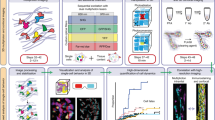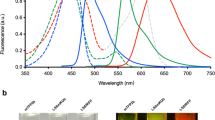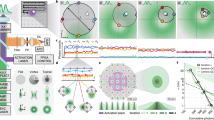Abstract
Fluorescent proteins are available in multiple colors and have properties such as intrinsic brightness and high quantum yield that make them optimally suited for in vivo imaging with subcellular resolution in the live mouse. In this protocol, cancer cells in live mice are labeled with green fluorescent protein (GFP) in the nucleus and red fluorescent protein (RFP) in the cytoplasm. GFP nuclear labeling is effected by linkage of GFP to histone H2B, and a retroviral vector is used for cytoplasmic labeling with RFP. Double-labeled cells are injected by various methods. High-resolution imaging systems with microscopic optics, in combination with reversible skin flaps over various organs, enable the imaging of dual-color labeled cells at the subcellular level in live animals. The double transfection and selection procedures described here take 6–8 weeks. Cancer cell trafficking, deformation, extravasation, mitosis and cell death can be imaged with clarity.
This is a preview of subscription content, access via your institution
Access options
Subscribe to this journal
Receive 12 print issues and online access
$259.00 per year
only $21.58 per issue
Buy this article
- Purchase on Springer Link
- Instant access to full article PDF
Prices may be subject to local taxes which are calculated during checkout








Similar content being viewed by others
References
Hoffman, R.M. The multiple uses of fluorescent proteins to visualize cancer in vivo. Nat. Rev. Cancer 5, 796–806 (2005).
Yamamoto, N. et al. Cellular dynamics visualized in live cells in vitro and in vivo by differential dual-color nuclear-cytoplasmic fluorescent-protein expression. Cancer Res. 64, 4251–4256 (2004).
Yamauchi, K. et al. Real-time in vivo dual-color imaging of intracapillary cancer cell and nucleus deformation and migration. Cancer Res. 65, 4246–4252 (2005).
Yamauchi, K. et al. Development of real-time subcellular dynamic multicolor imaging of cancer cell trafficking in live mice with a variable-magnification whole-mouse imaging system. Cancer Res. 66, 4208–4214 (2006).
Tsuji, K. et al. Dual-color imaging of nuclear-cytoplasmic dynamics, viability and proliferation of cancer cells in the portal vein area. Cancer Res. 66, 303–306 (2006).
Naumov, G.N. et al. Cellular expression of green fluorescent protein, coupled with high-resolution in vivo videomicroscopy, to monitor steps in tumor metastasis. J. Cell. Sci. 112, 1835–1842 (1999).
Condeelis, J. & Segall, J.E. Intravital imaging of cell movement in tumours. Nat. Rev. Cancer 3, 921–930 (2003).
Author information
Authors and Affiliations
Corresponding author
Ethics declarations
Competing interests
R.M.H. is President of AntiCancer Inc. and M.Y. is a Senior Staff Scientist at AntiCancer Inc. AntiCancer Inc. has commercial activities in the area of fluorescent-protein-based imaging and has a Technology Development Agreement with the Olympus Corporation.
Rights and permissions
About this article
Cite this article
Hoffman, R., Yang, M. Subcellular imaging in the live mouse. Nat Protoc 1, 775–782 (2006). https://doi.org/10.1038/nprot.2006.109
Published:
Issue Date:
DOI: https://doi.org/10.1038/nprot.2006.109
This article is cited by
-
Intravital imaging to study cancer progression and metastasis
Nature Reviews Cancer (2023)
-
Ischemia reperfusion-induced metastasis is resistant to PPARγ agonist pioglitazone in a murine model of colon cancer
Scientific Reports (2020)
-
Nuclear Nestin deficiency drives tumor senescence via lamin A/C-dependent nuclear deformation
Nature Communications (2018)
-
3′UTR polymorphisms of carbonic anhydrase IX determine the miR-34a targeting efficiency and prognosis of hepatocellular carcinoma
Scientific Reports (2017)
-
Generation and Application of Male Mice with Specific Expression of Green Fluorescent Protein in Germ Cells
Molecular Imaging and Biology (2016)
Comments
By submitting a comment you agree to abide by our Terms and Community Guidelines. If you find something abusive or that does not comply with our terms or guidelines please flag it as inappropriate.



